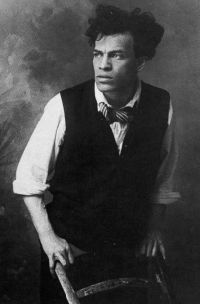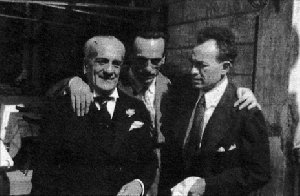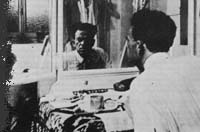Raffaele Viviani
(actor, poet and playwright)
Born in Castellammare January 9, 1888, from an early age showed his talent by taking part in numerous stage plays. The passion for the theater, he was sent by his father (also named Raphael), Margaret arena operator of Castellammare, theater in which they recited the poor "Pulcinelli" time. On the verge of bankruptcy shortly after the birth of Raphael, however, the Viviani family, because of a tax seizure, was forced to move to Naples, where in 1893, thanks to the recovery of props escaped seizure, built the theater "Masaniello." The theatrical debut of Viviani, occurred in 1892 and "New San Carlino", when "Papilluccio" (so called Raffaele was a child) to just over four years, she performed dressed in a red fracchettino, alongside her sister Luisella. The writer and journalist Dominic Rea in a 1991 article published in "The Friday of the Republic" recalled the celebrated Viviani, with this brief, but concise physical description:"I saw once Viviani walking around his home in Corso Vittorio Emanuele II. He was tall, dry, woody, skin and bones, dry face, snub nose, mouth flared, his eyes like a little 'cross-eyed, curly hair and woolly. was elegant in a bow tie, handkerchief in his breast pocket and black and white shoes. guappesca walked with air, but it was still a sad and noble gentleman commoner. " The humble origins of the family Viviani, strongly marked out the life of Raphael, sacrifices and hardships were the order of the day, when the untimely death of his father (Raffaele had just 12 years), aggravated the already difficult family circumstances, the loss of reference father, forced him to a street urchin forced maturity of head of household. Raffaele deprived of childhood had to necessarily believe in the activity inherited from his father. Bound by a sense of need, he managed with dogged determination to achieve rapid growth as an artist who saw lyricist, and very often the music of his plays. The works of Viviani, were appreciated the most important theaters in Italy and much of Europe. After a brilliant career, died March 22, 1950, aged 62.
We list below some of its
known theatrical masterpieces:
'O vico (1917), Tuledo 'e notte (1918), 'Nterr''a 'Mmaculatella (1918), 'O spusarizio (1919), Circo Equestre Sgueglia (1922), 'O fatto 'e cronaca (1922), Don Giacinto (1923), 'E piscature (1924), 'A musica d''e cecate (1928), 'A morte 'e Carnevale (1928), L'ultimo scugnizzo (1932).
Scarpetta, Eduardo and Viviani.
Viviani versatile artist, he also wrote several dialect poems, inspired by real-life subjects of neighborhood life. Thanks to the extraordinary beauty of the Neapolitan dialect, the "Genius Stabiese", was able to emphasize with singular skill, some aspects of social life typical of the era. To give a better idea of ??what was said, here's a poem written by Viviani in 1931 (Guide Publishers):
GUAGLIONE
Quanno pazziavo 'o strummolo, 'o liscio, 'e ffiurelle,
a ciaccia, a mazza e pìvezo, 'o juoco d''e ffurmelle,
stevo 'int''a capa retena 'e figlie 'e bona mamma,
e me scurdavo 'o ssolito, ca me murevo 'e famma.
E comme ce sfrenàvemo: sempe chine 'e sudore!
'E mamme ce lavaveno minute e quarte d'ore!
Giunchee fatte cu 'a canapa 'ntrezzata, pe' fa' a pprete;
sagliute 'ncopp'a ll'asteche, p'annaria' cumete;
po' a mare ce menàvemo spisso cu tutte 'e panne;
e 'ncuollo ce 'asciuttàvemo, senza piglià malanne.
'E gguardie? sempe a sfotterle, pe' fa' secutatune;
ma 'e vvote ce afferravano cu schiaffe e scuzzettune
e à casa ce purtavano: Tu, pate, ll'hè 'a 'mparà!
E manco 'e figlie lloro sapevano educà.
A dudece anne, a tridece, tanta piezz''e stucchiune:
ca niente maie capévamo pecché sempe guagliune!
'A scola ce 'a salavamo p''arteteca e p''a foia:
'o cchiù 'struvito, 'o massimo, faceva 'a firma soia.
Po' gruosse, senza studie, senz'arte e senza parte, fernevano pe' perderse: femmene, vino, carte,
dichiaramente, appicceche; e sciure 'e giuventù
scurdate 'int'a nu carcere, senza puté ascì cchiù.
Pur'io pazziavo 'o strummolo, 'o liscio, 'e ffiurelle,
a ciaccia, a mazza e pìvezo, 'o juoco d''e ffurmelle:
ma, a dudece anne, a tridece, cu 'a famma e cu 'o ccapì,
dicette: Nun pò essere: sta vita ha da fernì.
Pigliaie nu sillabario: Rafele mio, fa' tu!
E me mettette a correre cu A, E, I, O, U.
The company Autonomous Care Tourist Board of Castellammare, in 1959, erected in the public garden, a bust in memory of Raffaele Viviani. On 11 April the same year, was affixed to the house No. 14 (his native home), the then Ascent II Marquis de Turris (now Via Viviani, 12), a plaque made ??by the dean of Free Bears, which reads:
THIS HOUSE IN THE LIFE 9 January 1888 HAD THE MASK AND THE HEART OF RAPHAEL VIVIANI STABIA mindful.
In January 1962, the town of Castellammare as a tribute to the career of his illustrious son, he named after Raffaele Viviani, said the climb, which leads off from wide Peace Marquis de Turris (old city center). In times closer to us, he was named the IPSSAR (Professional Institute for Hotel and Catering Services) of Castellammare whose headquarters is at road Annunziatella, 23.




